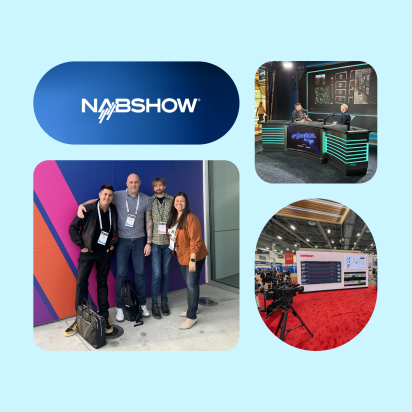Goodbye, 2020. Hello, 2021. We’re exhausted and excited.

Happy new year! To say the world changed in 2020 is obvious. And it’s clear that 2021 is off to a similarly wild and turbulent start.
But while the science isn’t conclusive about how long it takes to develop a new habit, we have lived through the pandemic and this transformative period long enough to shed old habits and develop new patterns and routines—good, bad or ugly. So, like any strategist, I chatted with teammates to reflect on what’s truly changed from last calendar year and what might stick to shape the new one for individuals, brands and organizations.
TL;DR: In a year that seemed to stand still for many, the most notable shifts weren’t new, but rather existing trends that accelerated at warp speed.
Goodbye, digital and physical. Hello, integrated living.
Brands have long drawn a distinction between digital and physical worlds. And individuals have often curated a version of our online selves that may not completely reflect the offline reality. While these lines have been blurring for some time, they completely collapsed once the world went into lockdown and we collapsed onto our couches. In 2020, we changed how we lived: we brought bosses and teachers into our homes via video chat, we shopped for groceries online that were delivered to our doors, we worked out in our homes with others across the country. No experience worked without the true integration of digital and physical.
We have to remember that the people and cultural factors are probably the most critical ones for success.
Even if 2021 doesn’t look exactly like 2020, the one constant is that change and emotional intelligence (or EQ-led leadership) are proven to build resilience. This doesn’t mean we abandon data or our “hard skills.” Instead, leading brands and organizations will understand how to listen and learn, find moments of emotion and empathy (at scale) in the data and continue to lean into what might feel uncomfortable. “We have to remember that the people and cultural factors are probably the most critical ones for success,” says Bruno Rebouças, Managing Director LATAM at MightyHive.
Whether you felt like everything came to a halt in 2020 or wouldn’t stop spinning, you made it to 2021. Breathe, but don’t rest too easy—for the strategists, designers and those who wake up every day to create the best experiences for others, this year is poised to be another one of change. Whether serving their teams or their customers, brands and organizations must know how to be resilient, nimble and empathetic. Fresh off a holiday break, I’m excited to explore and create better ways of living, learning, working and connecting with people at home and afar. Let’s get started!
This article contains contributions by Sarah Higbee, John O’Rourke and Joseph Sutton.
Brands must make sure they are using all the channels that are appropriate in ways that resonate with their customer.
Now, expectations are that winning experiences are truly integrated, adaptive and convenient. Even when it will be safe to socialize less than six feet apart, our hunch is the home will remain a critical hub that connects every aspect of our lives: Warner Bros. is eschewing theaters to premiere new movies at home through HBO Max, dating apps are connecting people from afar and virtual events offer greater accessibility than traditional, in-person counterparts. To continue to deliver on these new expectations of service, brands and platforms must adapt and rethink how, when and where consumers make decisions across increasingly nonlinear journeys—what Google calls “the messy middle.”
Michael Leen, SVP Growth and Partnerships at MediaMonks, recently discussed this new reality of everywhere commerce. “What differentiates brands and sellers today is their ability to show up where their customer is, whether it’s the dot-com, on TikTok or at an event. Brands must make sure they are using all the channels that are appropriate in ways that resonate with their customer.”
As marketers and designers, we must double down on human-centered design—and perhaps even think about home-centered design—by understanding how the present moment continues to shape content and connection.
Goodbye, surviving. Hello, thriving.
We’re living through a pandemic. We have to talk about our health—which includes physical, mental and emotional health. All too often, in US culture, “I’m busy” also signals “I’m important.” But in 2020, busy reached a breaking point without boundaries or rest, resulting in unprecedented burnout: for parents, for healthcare workers, for teachers and any and all essential workers (we see you, and we’re grateful). We couldn’t ignore our rising mental health challenges any longer.
In 2020, busy reached a breaking point without boundaries or rest.
Leading organizations understood this reality wasn’t just an individual challenge but also an organizational one stifling creativity, collaboration and problem solving, to name a few. With that, 2020 was the year we (finally) began to normalize mental health and take control of all aspects of our well-being—a priority that Firewood Co-founder and President Lanya Zambrano has championed by sharing her own journey.
Stressors won’t vanish when the pandemic ends. The good news is the rise and adoption of digital tools can help us better manage our health as individuals, like seeing a doctor via video chat with ease. But we’re also hopeful the conversation in 2021 moves beyond an afternoon of self-care to cultural norms of flexibility and balance.
Goodbye, traditional classrooms. Hello, lifelong learning.
Learning looked different this past year. So much so that metrics we’ve traditionally used to measure success (classroom size, test scores, etc.) essentially lost their relevance. What emerged in 2020 was something closer to the learner-centered approach that’s been championed for some time. Opportunities for anyone, at any age, to learn from anywhere with an internet connection took off: time spent learning on professional development platform LinkedIn Learning has tripled during the pandemic, while MasterClass saw a double in sales and raised $100 million to fund new content.
But the ways that education changed in 2020 weren’t all positive. Pandemic lockdowns exposed a digital divide that threatened to set underserved students and communities back further and showed how ill-equipped our institutions are in engaging students virtually when needed.
I believe that the most effective edtech experiences are built based on in-depth knowledge of what drives and engages kids and young adults.
As we look to this new year, there’s an incredible opportunity to imagine how we learn (anywhere) and who is a student (everyone) when we close the digital divide once and for all and consider new ways of learning. Might successful learning look like the Peloton model: personalized, entertaining and engaging group lectures supported by smaller discussion groups and communities?
“I believe that the most effective edtech experiences are built based on in-depth knowledge of what drives and engages kids and young adults,” says Vinne Schifferstein, Managing Director at MediaMonks Australia. “Only by truly stepping into their shoes can we motivate them to learn in a way that suits them best, ultimately resulting in better learner outcomes.”
I am not an educator and acknowledge that different solutions suit different ages and stages. But whatever this next year looks like, the opportunities for partnership, content and learning seem limitless.
Goodbye, geographical borders. Hello, shared values.
For the lucky industries and professionals who can work from the safe confines of home, how we work changed in 2020. And whatever model emerges (3-2-2 or others) this year, a distributed workforce will remain. Unrestrained by borders, the distributed workforce opens the door for more diverse backgrounds, experiences and perspectives, which will not only create better work but also means teams can source the best talent from all over the world.
Unrestrained by borders, the distributed workforce opens the door for more diverse backgrounds, experiences and perspectives.
But without shared physical spaces, norms or experiences that hold everyone together, leading organizations must instead rally around a set of common goals, values and purpose to create a community. Our values of humility, authenticity, inclusivity and responsibility have not only kept us connected and grounded throughout an unprecedented year, but have served as guideposts for designing content, programs and events across S4Capital—with a unified digital home on our bespoke internal platform, the Shift.
While this is not a new idea, it has become a cultural baseline to set future organizations and leading brands apart.
Goodbye, small talk. Hello, emotional intelligence.
Small talk changed in 2020. In a non-scientific, anecdotal survey of teams and client partners, platitudes about the weather and generally forgettable, time-filling conversations disappeared. They were replaced with conversations of grief, social justice, and wildfires (many of our teams live on the US west coast) because ignoring these topics felt tone-deaf. We had tough conversations. And consumers and communities expected brands to show up meaningfully to support their communities, customers and employees alike.
Related
Thinking
Sharpen your edge in a world that won't wait
Sign up to get email updates with actionable insights, cutting-edge research and proven strategies.
Monks needs the contact information you provide to us to contact you about our products and services. You may unsubscribe from these communications at any time. For information on how to unsubscribe, as well as our privacy practices and commitment to protecting your privacy, please review our Privacy Policy.



